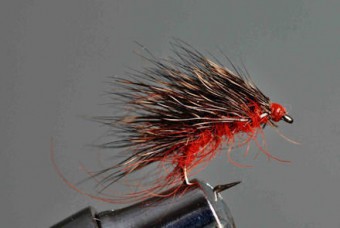In the latest instalment of Not Exactly Fishing, Gordon Mack examines a trout’s stomach and finds an age-old debate among the contents.

IT IS always interesting to explore the stomach contents of a trout. Where else would Skues, Sawyer and Goddard have found confirmation of their theories about the feeding habits of these fish, and their appetites for the rich variety of sub-surface life in our waters.
I have encountered trout so engorged with tiny snails that the food was spilling out of every orifice when landed. Which of course makes it all the more intriguing that a creature so greedy for a single food source, actually bothers to take my offered nymph, lure or wet fly at all – especially if it bears no resemblance to the rest of food it has just eaten.
And so I was not initially surprised when, gutting a fit, fat rainbow trout recently, I encountered a bloodworm in its gullet. What quickly proved more interesting, however, was that this particular bloodworm was firmly tied to a size 14 hook and trailing a small length of broken leader. On closer examination, the worm was clearly made of very realistic thin red rubber.
My first reaction was: bait – and artificial bait at that! On a fly-only reservoir surely this constituted illegal fishing: I confess I felt someone had been cheating. And on my next visit I showed the worm and its hook to the fishery manager for an opinion. He said that they were aware of the practice and were actively considering banning such tackle as not being in the spirit of fly-fishing.
But hang on a minute. If an artificial fly isn’t ‘bait’ what is it? And is a bloodworm ‘fly’ really any different from Sawyer’s wired Pheasant Tail Nymph, his Killer Bug or Bow-tie Buzzer or any one of the countless, caddis or epoxy buzzer or larvae patterns that have evolved down the years? The bloodworm is after all only the larvae of the humble chironomid midge and a staple element of the trout’s diet. Arguably more so than, say, a pink or yellow Blob.
Does the fact that the artificial bloodworm is made from perfectly tinted rubber, rather than natural fur and feather offend the purists? If so, what of the hundreds of modern imitative fly patterns constructed from new man-made materials such as fritz, flashabou, micro zelon, holo tinsel and foam?

I raised the discussion with Richard, an angling chum of long experience and a man equally at home with salmon, trout or carp rods. He was unequivocal: nothing wrong with it all. Just another development and a legitimate fly, he said, although it wasn’t a trout pattern he would choose to use himself, preferring more traditional wet and dry imitations.
So is that it: a matter of personal preference? If you want to tie a giant zonker, tartan blob or tiny rubber imitation bloodworm on to the end of your tippet and cast it into the water to haul out one of several thousand farm-fed rainbow trout all exactly 2.5lb in weight, then go head. Subject to local fishery rules, of course.
If you’d prefer to hike to some remote upland lake, loch or tarn, walk the banks or drift some rocky bays with a five-weight rod and small box of size 16 doubles first designed in 1890s, in search of an elusive wild brown trout, no-one will object or shout: unfair!
Perhaps you prefer mix-and-match tactics. Angling in general, and fly-fishing in particular, are surely broad enough churches to allow both of these approaches – and many other disciplines – to co-exist.

The ‘bait’ versus ‘fly’ debate is not new and has given rise over many decades to heated arguments that diverge into related topics like ‘live’ bait v ‘dead’ bait, asthetics, conscience and, sadly, class.
Even the definition of what constitutes a fishing fly is a real can of worms, if you’ll pardon the mixed metaphor.
The answers are as elastic as that rubber creation attached to a size 14 hook.
And probably just as meaningless.